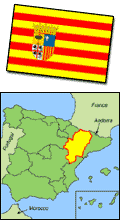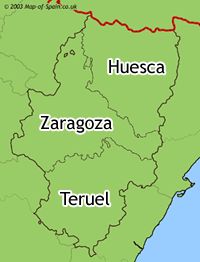 |
 Aragon Aragon
Aragon is made up of three provinces: This former kingdom, which once ruled the Mediterranean,
is currently of great interest and marked by contrasts and
magnificent countryside. It is also rich in folklore.
Zaragoza is the capital of Aragon. Bathed by the Ebro river,
it is one of Spain's leading cities. Of great importance during
Roman and Moorish times, its museum contains collections of
great interest. Among its architectural treasures is a medieval
cathedral.
 Teruel, which was dominated for a long period by the Moors,
boasts the magnificent opus of its excellent Mudejar architectural
school. Of special merit are the incredibly beautiful belltowers
of the cathedral and the churches of San Martin, san Pedro
and El Salvador.
Teruel, which was dominated for a long period by the Moors,
boasts the magnificent opus of its excellent Mudejar architectural
school. Of special merit are the incredibly beautiful belltowers
of the cathedral and the churches of San Martin, san Pedro
and El Salvador.
The founding times of Huesca, capital of the Aragonese Pyrenees,
are lost in the mists of prehistory. It stands on a hill overlooking
the rich orchard lands of the river Isuela. Next to old buildings,
there are other of modern construction, which were built following
the example of civil Aragonese renaissance architecture. As
a result the urban picture as a whole is nicely balanced.
Among
the most important sights there are San Pedro El Viejo, with
a lovely Romanesque cloister, a Gothic retable and the sepulchres
of King Ramiro II of Aragon and Alfonso I El Batallador;
the 13C cathedral, with an interesting main portal, a Gothic
cloister
and the main retable by Damian Forment; San Miguel's and
San Lorenzo's; the Romanesque Salas sanctuary; the Renaissance
Town Hall, with an interesting hall and staircase; the old
University, reformed in the 17C; and the house of the Climent
family. A visit of the sights must include the Provincial
Archaeological
Museum with exceptionally interesting Romanesque and Gothic
retables and a collection of sculptures and paintings, not
forgetting the archaeological remains. The museum of the
cathedral is also interesting. Outstanding in the province is Jaca on the banks of the Aragon.
It used to be the favourite residence of the Aragonese kings,
and today it is a lively, important town with a magnificent
collection of sights. especially interesting is the 10C Romanesque
cathedral, a key building of medieval architecture, and the
Romanesque museum. Also noteworthy are the Town Hall, which
is an example of Aragonese Plateresque, the convent of the
Benedictine nuns, with the sarcophagus of Queen Doña
Sancha, the mighty citadel, which was begun in 1592 and restored
recently, the Gothic San Cristobal and the Romanesque San Miguel
bridges. The Museum of Romanesque Painting is also very important.
Other places of note are Canfranc, a centre of international
railway connections; Panticosa in the Tena valley, which is
a highly important spa; Sabiñanigo, with the important
complex of El Serrablo which has the main Aragonese examples
of Mozarab art -in Larrede, Satue, Isun, Oros-Bajo, Susin;
Torla and Bielsa, typical mountain villages; Sallent de Gallego,
an outstanding skiing resort with a remarkable parish church;
Ainsa, the architecture of which looks medieval, where the
arcaded square, the tall Romanesque tower of Sant Maria's and
many houses with fine Gothic and Plateresque windows are especially
outstanding; Benasque, a mountain village with a very interesting
urban layout; and Tolva, with a remarkable church dating from
1130. Roda de Isabena is especially important form the point
o view of art and history - it has a magnificent cathedral
with a remarkable museum, and Graus, a rich important place
with a lovely Plaza Mayor (main square) and the famous sanctuary
of Nuestra Señora de la Peña. Other interesting
places are Anso, Hecho, Berdun, Villanua, Biescas, Broto, Boltaña,
etc.
Near the Province of Lleida in the southern region there are
three important places: Barbastro, Morzon and Fraga. Barbastro,
of Roman origin and a Muslim stronghold, is surrounded by rich
orchard lands and vineyards. Its important sights include the
cathedral, which was built in the first quarter of the 16C
and has a very valuable main retable by Forment, the Episcopal
Palace, Pueyo Monastery, the Town Hall, the arcaded Plaza Mayor
and various stately houses with large, richly carved wooden
eaves, among them the house of the Argensola family.
Near Babastro
lies the village of Alquezar with many important sights.
Monzon -on the banks of the Cinca, the surroundings of which
are densely
cultivated and dotted with hamlets - lies beside a hill which
has a famous castle of the Knights Templars on top. Especially
outstanding is the Romanesque Church of Santa Maria where
the Court of Aragon held its sessions several times.
On the banks
of the Cinca, finally, there is Fraga of Iberian origin,
where important Romanesque churches of the 12C are preserved
as is
a series of residential buildings in the picturesque layout
of the streets. In the vicinity of Fraga, there are the Roman
remains of the so-called Villa Fortunati, dating from the
2C and 4C. Its Visigothic church dates from 7C.
 |

See
what tours we have available here! |
Book Organized Tours of Spain
Popular tours sell out well in advance! Don't be
disappointed!
Reduce stress! Don't waste time haggling with the hotel concierge.
Lock in your price! Currency dips & price hikes won't effect you.
Save vacation time! Plan & book now, not when you're there.
Balance your vacation budget! Charge tours on this month's credit card bill. |
|

See
what tours we have available here! |
 |
|
 |




